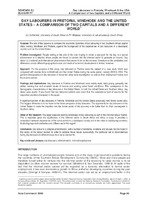| dc.contributor.author | Schenck, Catherina (Rinie) | |
| dc.contributor.author | Blaauw, Phillip (Derick) | |
| dc.date.accessioned | 2014-01-21T20:26:20Z | |
| dc.date.available | 2014-01-21T20:26:20Z | |
| dc.date.issued | 2008 | |
| dc.identifier.citation | Schenck, C.J. & Blaauw, P.F. (2008). Day labourers in Pretoria, Windhoek and the United States - a comparison of two capitals and a different world. Acta Commercii, 8(1): 90 - 102 | en_US |
| dc.identifier.issn | 1684-1999 | |
| dc.identifier.uri | http://hdl.handle.net/10566/960 | |
| dc.description.abstract | Purpose: The aim of this paper is to compare the economic dynamics of day labouring in two Southern African capital cities, namely Windhoek and Pretoria, against the background of the experiences of day labourers in a developed country such as the United States.
Problem investigated: People waiting at the side of the road, hoping to obtain a piece job for the day, is a typical phenomenon in a situation where people are forced to venture into the informal sector to generate an income. Day labour is a national and international phenomenon that seems to be on the increase. Literature on the similarities and differences across different geographical areas and levels of economic development is limited, however.
Approach: For the purpose of this study, day labourers in Pretoria were the subject of a case study which was compared with studies done in Windhoek and the United States during the same period, namely 2003 to 2004. The general demographics of day labourers in these two cities were investigated, as well as their employment history and the income earned.
Findings and implications: Day labourers in Pretoria and Windhoek were mainly male, fairly young, generally low skilled, earning low and uncertain levels of income and working under harsh conditions. This corresponds to the demographic characteristics of day labourers in the United States. In both the United States and Southern Africa, day labour pays poorly. It was found that day labourers seldom earn more than the subsistence level of income for the respective countries discussed in this paper. A significant portion of day labourers in Pretoria, Windhoek and the United States previously held formal sector jobs. The biggest difference is to be found in the future prospects of day labourers. The opportunity for day labourers in the United States to make the transition into the formal sector of the economy is far better than for their counterparts in Southern Africa.
Value of the research: The paper expands existing knowledge of day labouring as part of the informal labour market. This is important given the significance of the informal sector in South Africa and Africa at large. It provides a comparison between experiences of the same activity in a developed country and in two cities in developing countries, illustrating important similarities and differences in this regard.
Conclusion: Day labour is a complex phenomenon, and a number of problems, violations and abuses may be found in this sector of the labour market. In order to address these issues successfully, the particular set of circumstances facing day labourers in different areas must be accounted for. | en_US |
| dc.language.iso | en | en_US |
| dc.publisher | AOSIS OpenJournals | en_US |
| dc.rights | © 2008 Schenck & Blaauw; licensee AOSIS OpenJournals. This is an Open Access article distributed under the terms of the Creative Commons Attribution License, which permits unrestricted use, distribution, and reproduction in any medium, provided the original work is properly cited. | |
| dc.subject | Comparison | en_US |
| dc.subject | Day labourers | en_US |
| dc.subject | Economic dynamics | en_US |
| dc.title | Day labourers in Pretoria, Windhoek and the United States - a comparison of two capitals and a different world | en_US |
| dc.type | Article | en_US |
| dc.privacy.showsubmitter | false | |
| dc.status.ispeerreviewed | true | |
| dc.description.accreditation | Department of HE and Training approved list | en_US |

